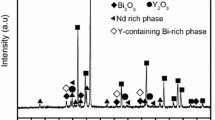Abstract
The microstructure and electrical properties of ZnO-based varistors with the SiO2 content in the range of 0–1.00mol% were prepared by a solid reaction route. The varistors were characterized by scanning electron microscopy, X-ray diffraction, energy-dispersive X-ray spectrometry, inductively coupled plasma-atomic emission spectrometry, and X-ray photoelectron spectroscopy. The results indicate that the average grain size of ZnO decreases with the SiO2 content increasing. A new second phase (Zn2SiO4) and a glass phase (Bi2SiO5) are found. Element Si mainly exists in the grain boundary and plays an important role in controlling the Bi2O3 vaporization. The electric measurement shows that the incorporation of SiO2 can significantly improve the nonlinear properties of ZnO-based varistors, and the nonlinear coefficients of the varistors with SiO2 are in the range of 36.8–69.5. The varistor voltage reaches the maximum value of 463 V/mm and the leakage current reaches the minimum value of 0.11 μA at the SiO2 content of 0.75mol%.
Similar content being viewed by others
References
D.R. Clarke, Varistor ceramics, J. Am. Ceram. Soc., 82(1999), p.485.
D. Xu, L. Shi, Z. Wu, et al., Microstructure and electrical properties of ZnO-Bi2O3-based varistor ceramics by different sintering processes, J. Eur. Ceram. Soc., 29(2009), p.1789.
M. Matsuoka, Nonohmic properties of zinc oxide ceramics, Jpn. J. Appl. Phys., 10(1971), p.736.
T.K. Gupta, Applications of zinc oxide ceramics, J. Am. Ceram. Soc., 73(1990), p.1817.
T. Takemura, M. Kobayashi, Y. Takada, and K. Sato, Effects of antimony oxide on the characteristics of ZnO varistors, J. Am. Ceram. Soc., 70(1987), p.237.
E. Olsson and G.L. Dunlop, The effect of Bi2O3 content on the microstructure and electrical properties of ZnO varistor materials, J. Appl. Phys., 66(1989), p.4317.
M. Peiteado, M.A. De, M.J. Velasco, et al., Bi2O3 vaporization from ZnO-based varistors, J. Eur. Ceram. Soc., 25(2005), p.675.
C.C. Lin, W.S. Lee, C.C. Sun, and W.H. Whu, The influences of bismuth antimony additives and cobalt manganese dopants on the electrical properties of ZnO-based varistors, Compos. Part B, 38(2007), p.338.
S.G. Cho, H. Lee, and H.S. Kim, Effect of chromium on the phase evolution and microstructure of ZnO doped with bismuth and antimony, J. Mater. Sci., 32(1997), p.4283.
K.O. Magnusson and S. Wiklund, Interface formation of Bi on ceramic ZnO: a simple model varistor grain boundary, J. Appl. Phys., 76(1994), p.7405.
S. Bernik and N. Daneu, Characteristics of ZnO-based varistor ceramics doped with Al2O3, J. Eur. Ceram. Soc., 27(2007), p.3161.
J. Ott, A. Lorenz, M. Harrer, et al., The influence of Bi2O3 and Sb2O3 on the electrical properties of ZnO-based varistors, J. Electroceram., 6(2001), p.135.
C. Lin, Z. Xu, P. Hu, and D.F. Sun, Bi2O3 vaporization in microwave-sintered ZnO varistors, J. Am. Ceram. Soc., 90(2007), p.2791.
R. Einzinger, Metal oxide varistors, Ann. Rev. Mater. Sci., 17(1987), p.299.
T.R.N. Kutty and S. Ezhilvalavan, The role of silica in enhancing the nonlinearity coefficients by modifying the trap states of zinc oxide ceramic varistors, J. Phys. D, 29(1996), p.809.
S.J. So and C.B. Park, Improvement in the electrical stability of semiconducting ZnO ceramic varistors with SiO2 additive, J. Korean Phys. Soc., 40(2002), p.925.
C.W. Nahm, Effect of cooling rate on degradation characteristics of ZnO·Pr6O11·CoO·Cr2O3·Y2O3-based varistors, Solid State Commun., 132(2004), p.213.
B.A. Haskell, S.J. Souri, and M.A. Helfand, Varistor behavior at twin boundaries in ZnO, J. Am. Ceram. Soc., 82(1999), p.2106.
A. Rečnik, N. Daneu, T. Walther, and W. Mader, Structure and chemistry of basal-plane inversion boundaries in antimony oxide doped zinc oxide, J. Am. Ceram. Soc., 84(2001), p.2657.
S. Bernik, N. Daneu, and A. Rečnik, Inversion boundary induced grain growth in TiO2 or Sb2O3 doped ZnO-based varistor ceramics, J. Eur. Ceram. Soc., 24(2004), p.3703.
C.N. Ye, N.Y. Tang, X.M. Wu, et al., XPS analysis of Ge-SiO2 thin film, Microfabr. Technol. (in Chinese), 1(2002), p.36.
C.W. Nahm, The effect of sintering temperature on electrical properties and accelerated aging behavior of PCCL-doped ZnO varistors, Mater. Sci. Eng. B, 136(2007), p.134.
Author information
Authors and Affiliations
Corresponding author
Rights and permissions
About this article
Cite this article
Wu, Zh., Fang, Jh., Xu, D. et al. Effect of SiO2 addition on the microstructure and electrical properties of ZnO-based varistors. Int J Miner Metall Mater 17, 86–91 (2010). https://doi.org/10.1007/s12613-010-0115-0
Received:
Revised:
Accepted:
Published:
Issue Date:
DOI: https://doi.org/10.1007/s12613-010-0115-0




